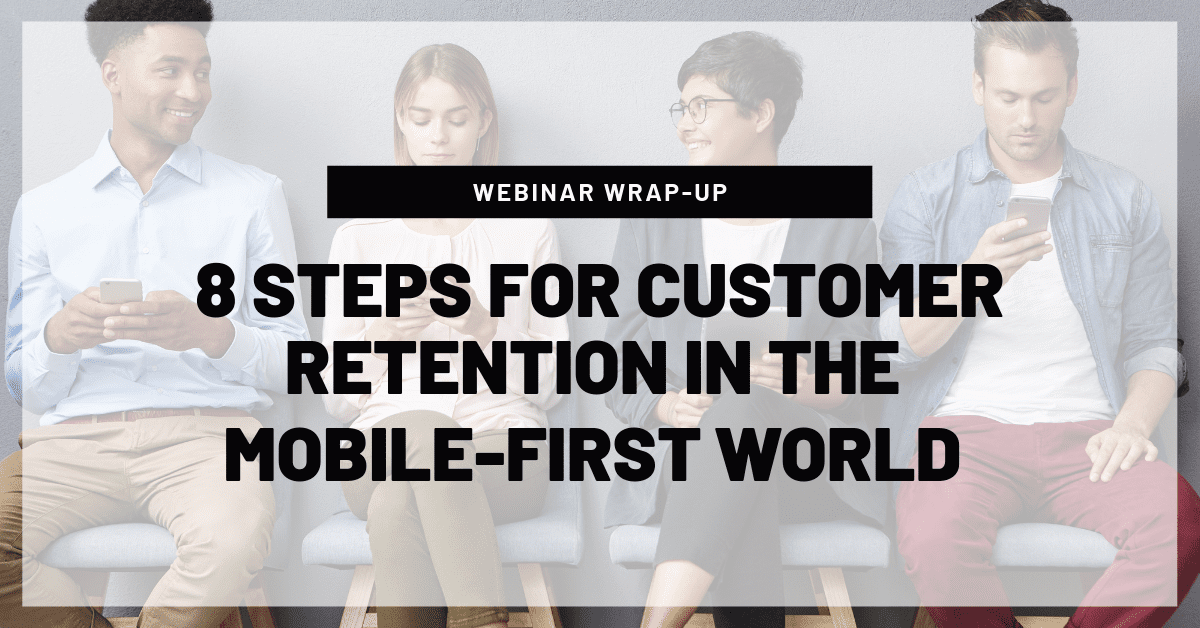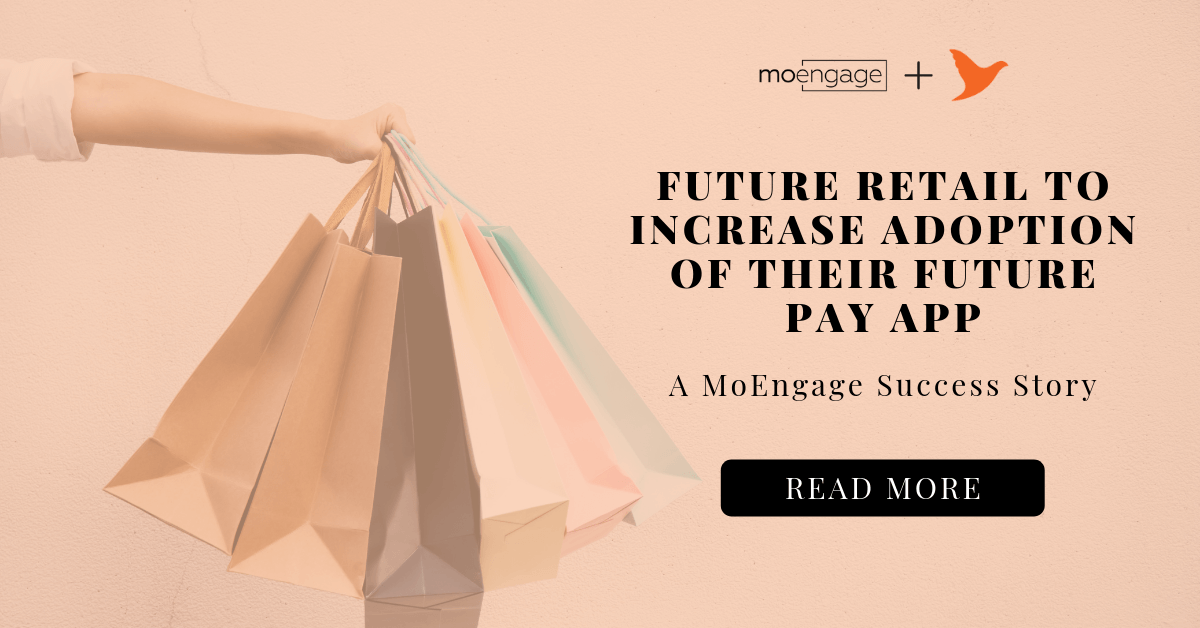8 Effective Steps for Customer Retention in a Mobile-first World

Reading Time: 6 minutes
|
Landlines are almost dead. Desktops are rarely used. On the other hand, mobiles have become the go-to tool for anything – from shopping online to reading news; modern-day customers resort to mobiles as their first choice for getting things done.
For marketers, the mobile-first world is a double-edged sword. It is made up of millions of apps on app stores and in-the-moment experiences, making it a tough place to survive. Even the slightest misstep can send the customer swirling away in the direction of dozens of other distractions. Ensuring customer retention in a mobile-first world requires a strategic approach.
| Bonus Content
👉 Definitive Buyer’s Guide To Customer Engagement Platform [Download Ebook] 👉 E-commerce App Retention Trends India 2020 [Download Report] 👉 Customer Engagement During Crisis Playbook [Download Ebook] |
In a recent MoEngage webinar, Richard Shapiro, Founder and President of The Center for Client Retention, and Ehren Maedge, VP of Digital Engagement (US), MoEngage, broke down 8 surefire ways for customer retention in a mobile-first world.
Watch the webinar below, or continue reading for a summary of this webinar.
Richard Shapiro brought to the webinar his knowledge of customer retention accumulated over three decades. His first lessons on customer engagement were learned as a child at his father’s shop, where he worked as a cashier. There are three basic tenets that Richard stresses for customer engagement. Although learned decades ago, these tenets remain relevant even in the mobile-first age.
- In the mobile-first world, users are people first and then customers.
- Make customers feel welcome right from the first engagement – right from the moment they enter the mobile app or website.
- Create a relationship with customers. Relationships are what tie consumers together. Circling back to the first lesson, all customers are people first.
Why Customer Retention Matters Now More Than Ever
The internet has created an open field for all. There are fewer barriers to entry. Even teens are launching self-owned businesses with zero capital. As a result, almost every industry has become far more fragmented and competitive. There are more options for customers to buy from and more channels to explore these options. Customer engagement is the trump card for businesses to win in this hyper-competitive world.
Customer Retention Weighs More Than Customer Acquisition – Here’s Why
Every business sets ambitious goals to acquire new customers. They fix targets on how many customers, downloads, and signups must be acquired in a given period. Invariably, the majority of businesses determine their success based on an increase in customer acquisition.
If we were to balance customer retention and acquisition on a weighing scale, customer retention would weigh more. Ehren managed to excavate some hard-hitting statistics that prove the same.
- Acquiring a new customer is 5x more expensive than retaining an existing customer.
- Selling to an existing customer has a 60% to 70% higher success rate.
- Also, focusing more on serving existing customers increases loyalty. A study by American Express also found that 86% of customers are willing to pay more for a better customer experience.
Also, customer acquisition costs are consistently increasing, even with multiple channels for reaching customers. Retaining and engaging an existing customer is easier than acquiring new customers.
Steps for customer engagement in the mobile-first world
Step #1: Fulfill their hopes
Customers use a mobile app with the hope that it will fulfill their needs and aspirations. Although most users do not recognize it when they approach a store, they are driven by the strongest human emotion – that is hope. Right from the first instance, the mobile app should prove itself capable of living up to the expectations of the user.
Robert cited the example of a beauty product. Customers visit the product’s website with the hope that they will be able to find the right product that will make them look younger or feel great. Such a feeling can be provided only if the app’s workflow is personalized to deliver an exceptional customer experience at every juncture of the user’s journey.
Tokopedia was able to personalize its customers’ user experience with automated workflows that were tightly integrated with cross-channel campaigns. This personalization achieved with MoEngage enabled Tokopedia to improve its app retention rates by 60%.
Step #2: Personalize the message
The business must know who the customer is on an individual level. Attention to small details like addressing the customer by name and having a human tone to the marketing message all contribute to mobile customer engagement. The baseline is to treat them as people, not just customers who pay money.
That’s exactly what Jabong did. They moved from mass mailing to a hybrid communication system that can help them send contextual and personalized offers to customers. Learn more about Jabong’s success story in this video.
Step #3: Deliver more than asked
To create moments of engagement in a constantly distracted customer mind, it is essential to predict their needs and serve them efficiently. Proactive service is a sure-fire way to build trust. The focus should be on creating a unique experience that serves customer needs.
A unique experience is created when your app is able to deliver more than what is asked of it. Fave was able to win the rapt attention of users with push notifications and SMS bursts that educated them on how to best use their product features. Read more…
Step #4: Know your product or service better than anyone else
In the mobile-first world, customers have access to information more than ever. Also, they themselves hold information like their user personas, location, preferences, etc., which, if tapped into by the business, can result in better engagement.
Ayopop had trouble retaining customers and ensuring they renewed their subscriptions on time. With MoEngage’s Sherpa AI, they were able to shoot personalized and well-timed messages that subtly reminded customers that their subscriptions were nearing expiration. This helped Ayopop increase its transactions by 200%.
Step #5: Don’t deny your customers
NO might be a two-letter word. But the customer hears it as a seven-letter word, which is good-bye. In a mobile-first scenario, NO is said in my forms. It could come in the form of not recognizing a repeat customer or optimizing the app experience for hassle-free transactions, irrelevant messaging, and so on.
Richard prescribes identifying and addressing repeat customers, using relevant messaging, and delivering a smooth experience to heighten customer engagement.
For example, Future Retail, India’s biggest retail chain, developed the Future Pay app to adapt to the changing shopping landscape. Through this digital wallet app, consumers get an option to transact across all Future Retail Brands. Consumers use the Future Pay app as a digital wallet and accumulate loyalty points, receive personalized promotions games that reward and engage with customer support. One of their biggest wins was establishing unified customer engagement across Future Retail brands and standardizing customer analytics and campaigns for multiple teams. Take a look.
Step #6: Invite me to return
Customers need a small nudge to remind them of your brand and their previous interactions. Richard advises against stopping your customer interaction with just order confirmations. Extend it further with push notifications, feedback surveys, thank-you emails, etc.
But how do you follow up on interactions with customers who seem to have lost touch with the app? MoEngage’s Uninstall tracking and analytics-enabled apps like HelpChat reconnect with users through email campaigns. The personalized email campaigns powered by Artificial Intelligence helped boost the open rates by 34%.
| Bonus Content
👉 Beginner’s Guide to Omnichannel Marketing for 2021 [Download Ebook] 👉 Customer Lifecycle Marketing Campaigns: An In-depth Guide for 2021 [Download Ebook] 👉 Customer Lifecycle Marketing Campaigns: An In-depth Guide for 2023 and Beyond – [Read Blog] |
Step #7: Show me I matter
One of Richard’s early lessons in customer engagement was to make the customer feel welcome. In the mobile-first world, where most communication happens virtually, making customers feel important could be difficult.
Richard shares that sending targeted messages or dynamic content suggestions could help increase engagement exponentially. The idea is not to send random offers that are of no relevance but to communicate with the customer with relevant offers.
The challenge is sending the right content at the right time and to the right user segment. If done right, it could take user engagement to new heights. Tiket.com, is a leading online ticketing platform offering flight, hotel, car rental, attractions, and popular event bookings in Indonesia. The brand automated customer journeys to reduce churn and drive purchases on the app. Take a look.
Step #8: Don’t just serve; surprise them
As individuals, every customer craves attention. How can a business in the mobile-first world attract attention? Richard opines that wishing birthdays may be the old style. A slightly better way would be to wish them on their important milestones, like business founding anniversary, first-order anniversary, number of orders, etc.
Conclusion
A slight increase in customer loyalty, even to the tune of 5%, can increase lifetime profits per customer from 25% to 95%. And it all begins with treating the customer as a person first and then as a customer.
Brands like Tokopedia, BerryBenka, McAfee, Samsung, Travelodge, Jabong, T-Mobile, and Mashreq Bank maximize their customer engagement with MoEngage’s AI-driven intelligent marketing platform. Your brand could be next.
Here’s what you can read next: |














